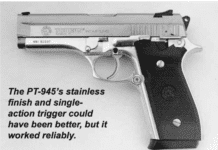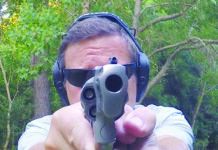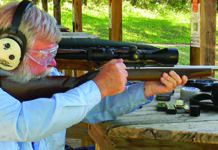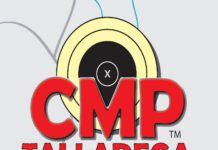Re: “Is Ruger’s New Gunsite Scout Rifle
a Pretender, or Contender?” May 2011
I read the May issue of Gun Tests and it was excellent as usual. I have a question regarding the Scout rifle test. I’ve read where the magazine on the Ruger Gunsite Scout was made by Accuracy International. I did not read this in the article, so my question is: Have you heard or read the same thing? If this is the case, my next question would be to Ruger: Why use a magazine by Accuracy International, which is a excellent firearms manufacturer, instead of a M-14 mag, or an Armalite mag, DPMS mag, or an FN FAL mag? I figure that using an alternate mag maker would possibly correct the difficult feeding problem you encountered during the test with the Ruger.
Thanks for making a great magazine and keep up the good work.
—Mike Penrod
Vowells Mill, LA
Mark Gurney, Product Manager for Sturm, Ruger & Co. Inc. answers:
Thank you for the opportunity to answer your reader’s questions regarding the Ruger Gunsite Scout Rifle.
Truth be told, our first choice was to use an M-14 magazine, and our first prototype was built around a 20-round M-14 magazine, and it cycled just fine. However, the rifle wouldn’t feed from other magazines (mil-spec mags that otherwise ran fine in an M-14) due to variations in cartridge-presentation height.
We then tried FAL magazines, and the variations in those magazines were far worse.
While an AR-10 or other AR-style magazines would be another obvious choice to try, they are side-latched and would require considerable design changes in the receiver or the stock to retain the magazine in the action.
The tapered-stack, center-feed magazines we ultimately chose were already in production, in use in a number of higher-end rifles, and are currently sourced from Accurate-Mag of Connecticut. They have been loosely described as “AICS” or “AI-pattern” magazines, as Accuracy International is often credited as the first manufacturer to use the magazine system. However, the AI system was reportedly developed from a Parker-Hale or Enfield-Parker design, and I have been advised by Accurate-Mag that perhaps the best modern designation is an “M-24 style” or “M-40 style” magazine, as this magazine system is utilized in our military’s currently issued sniper rifles.
The magazine is battlefield reliable, with a relatively stout spring to ensure cartridges are positively lifted into place. The force on the cartridge against the magazine feedlips can be felt, especially when shooting slowly from the bench. Once “broken in,” the action and magazine smooth up considerably, and when shooting in the field, running the bolt quickly, the extractor will snap over the rim as designed (it is still a controlled-round feed Mauser action) and the bolt will close more smoothly.
Please feel free to contact us should you or your readers have any other questions.
I received your review of the Ruger Gunsite Scout vs. Steyr Scout in the May 2011 issue about the same time that a Ruger Scout showed up at the gun shop in town (Hickman Rifles).
Your review mentioned that Savage makes a scout version. I’d love to see a comparison of the Ruger Scout vs. the Savage Model 10 FCM Scout.
Thank you for a valuable and interesting publication.
—Dan
Colorado Springs
We’re working on the Savage. ~Todd Woodard
The Scout Rifle is a useful concept. But with the advent of lightweight AR-10 type platforms and the Springfield SOCOM 16, the bolt-action Scout is obsolete.
—Larry Cox, via email
Re: “Downrange,” June 2011
As a follow-up to your Open Carry opening in Gun Tests, here are just a few more thoughts. I have a CHL and support Open Carry, but would never do it myself for the following reasons: 1) I don’t want anyone to know I have a weapon because if I am carrying out in the open I lose my element of surprise; I quickly become an active target if I’m caught up as a bystander in a criminal act, and I can become the target of some trash-talking anti-gun drum beater. 2) If I open carry, now I need to be concerned about the type of holster that can help prevent acquisition of my weapon by someone else as well as the physical training involved to be able to effectively resist this type of action. This tired old body just ain’t as flexible as it used to be, and I want a weapon to protect myself, not to make me a larger target. By the way, Gun Tests is an awesome publication!
—Ralph Krueger, via email
Re: “Classic Military 9mms:
Luger Falls to High Power, Walther,” June 2011
I like the article, and I own each of those firearms. If you want to feed any ammo, I found the P-38 to be a tad more reliable than the Hi-Power. The Luger, however, often gets a bad reputation because it has “modern problems.” Problems we label it with, without treating the gun correctly. Like putting diesel in an unleaded vehicle. Not the car’s fault.
If you treat the gun correctly after replacing faulty parts you would have been more pleased with it. As a combat arm for today’s use, I would agree on a D grade. When the guns is treated properly and in its role in history, it deserves at least a C+ or B- in my opinion. Some other points include:
- The Luger 9mm round would not exist without the P08.
- The Luger was ONLY designed for RN FMJ.
- Today’s velocities are far too low for most Lugers, as 1250 fps+ is needed for most to cycle perfectly.
- If you have a WWII Luger, you may have defective parts, as this was commonly done by the prison labor. Generally, the firing pin was just hard enough to pass tests before leaving the factory.
- Due to tight tolerances of the gun, it MUST stay clean and lubricated correctly to function well.
- While this sounds odd, the best grouping and cycling occurs when the gun is held moderately firm but limp-wristed.
That mag release on the side was copied from the P08. The frame and slide design has also been copied with credit incorrectly given to Glock. With this said, I love all three. To use as combat arm today, I would use the P38 due to its higher reliability. Hi-Powers are a bit touchy if the trigger group gets dirty. Not the case of the P38. Good article, and thank you for letting me add some history for you.
—Garry, via email
Today I received the June issue and believe that the best WWII 9mm was omitted: the Radom. I have one that my dad’s younger brother brought home from WWII. It was taken from a woman driver of a halftrack during the Battle of the Bulge. My uncle was in the army when the war started, and from a cavalry officer he learned the history of this pistol. He related that a Polish cavalry officer developed it to stop the troops from shooting their horses themselves or other troops. The Radom has a hammer designed to be cocked on the saddle, one’s chaps, or pants. The decocking lever was to allow it to be uncocked with one hand while controlling a horse with the other. You can put a wooden dowel in the hole in the hammer to create a fail-safe safety, for the slide covers part of the hammer’s hole. I qualified on the 25-yard target with a 289 out of 300, which I think is good with the hard trigger it has.
—Dave Tull,
Sahuarita, AZ
Re: “40s From Kahr, Sigarms, S&W:
Should You Pick DA-SA or DAO?,” July 2005
I am a subscriber to your magazine. I was wondering if I could get the issue from July 2005? I was wondering what ammo you used for the testing of the S&W 40. I have a S&W 40 SIG V Model and a Taurus Millennium 40 cal. They both shoot the same—aim high (like a head shot), and it would hit the chest area. The only thing I can think of is to buy different ammo to try.
—Rodney Noll, via email
Sure, log on to www.Gun-Tests.com and order the back issue.
In that test, we shot a Black Hills 180-grain JHP, a Federal Hydra-Shok 135-grain JHP, and a Cor-Bon 135-grain JHP. The Kahr P40 was our pick in that test. As for the Smith, it got a “Buy It” rating, with these comments: “There were no malfunctions with the Smith. We had great difficulty with our target testing because of the 12-pound trigger. Despite that, we regularly got 2-inch groups; plenty good enough, we thought, for whatever you’d want to do with this pistol, though it was no fun to shoot deliberately.
We liked the looks of the gun, its low placement in the hand, its simple functionality, its reliability and accuracy, and its relatively low price. If it had a decent trigger, say 8 pounds, we’d love this gun. We tried it rapid fire, and it worked way better than we’d hoped. The great pressure on the trigger probably compensated for some of the recoil, and we found we were able to shoot it very fast with good accuracy. In that respect it performed better than the Sig. But for the weekend tin-can buster, this .40 S&W gun would be a total loss, we thought. However, the relatively low price of the Smith might make a trigger job an attractive option.”
Older-Gun Evaluations
If I can add my two cents worth to Bill’s letter in the June 2011 issue, I just want to say that I, too, very much enjoy your ongoing evaluations of older guns. Please keep them coming!
—Andy Porter, via email
They are a lot of fun. ~Todd Woodard
No More “Coming Up?”
I just received my current edition, and I noticed that the last page no longer showed “Coming Up in Future Issues.” Is that a mistake, or will that notice no longer be included? I looked forward to that each edition and will miss it if it will no longer be included.
—Lou Sarlo, via email
No, I was just super-short on space and had a choice to cut the upcoming story list or hack on Ray Ordorica’s last feature. First time that’s ever happened. Probably won’t ever happen again. ~Todd Woodard
Complete Set of Back Issues Available
I have a complete set of both Gun Tests and American Gunsmith magazines (1993 to date) if any of your readers are interested.
—Charles Krall
Inexpensive Ammunition
Like everyone else, I try to save money when possible. I have been seeing ads for inexpensive ammo, and I am unfamiliar with some of these brands. Brands I have seen listed include: Tula, PMC, CCI/Speer, Military Ballistics Industries, BVAC, Aguila, Sellier & Bellot, Ultramax, Fiocchi, LVE, Prvi Partizan, Novo, Wolf (WPA), Armscor, Barnaul, RWS, Magtech, and Independence.
Perhaps you can do an article summarizing the qualities of these brands and include the less expensive brands of Federal, Winchester, and Remington.
I am interested in: place of manufacture, reloadability, corrosiveness, dirtiness, reliability, and accuracy.
I understand that you cannot thoroughly test every brand in every caliber, but perhaps you or your testers or other readers can simply give their opinions. Thank you.
—Jim Stolba, via email
We regularly test several of these brands, and we’ll include them when it’s appropriate to the category we’re testing. ~Todd Woodard
Pearce Extender for Glock 27
In reply to R. Carter in the May 2011 issue concerning getting pinched by the Pearce Extender on his Glock 27:
I have carried the Glock 27 for a least seven years as a probation officer. I am required to carry concealed in the field. Our armory installed Pearce extenders on the 27, and I have shot many hundreds of rounds through it, and I have never encountered the problem of “pinching.”
Additionally, the gun would be completely disassembled for departmental checks and service, including magazine disassembly and reassembly, and there have never been any issues.
I would question whether the magazine is a factory mag, and also check the Pearce extender carefully to make sure it has been properly installed. Certainly, if he hasn’t done so, disassemble the mag and check for any problems on either item where the parts fit together when assembled. One interesting note: Previous to carrying the Glock 27, I carried the Glock 23 and always shot very well with it. When I opted to carry the 27 instead, I, as well as others, assumed that the shorter barrel and grip would translate into lower qualification scores. I found that the Glock 27 with Pearce extender was very shootable. In fact, I took departmental high-score honors one year with that gun against 23s and 27s. It definitely was more concealable and easier to draw from a Level 3 retention holster. Since then, I have added a Pearce to my personal Glock 23, which I carry on a duty belt for uniformed carry. Though not needed for length, I think it still gives a bit more control.
—David Spielman,
Liverpool, NY




























